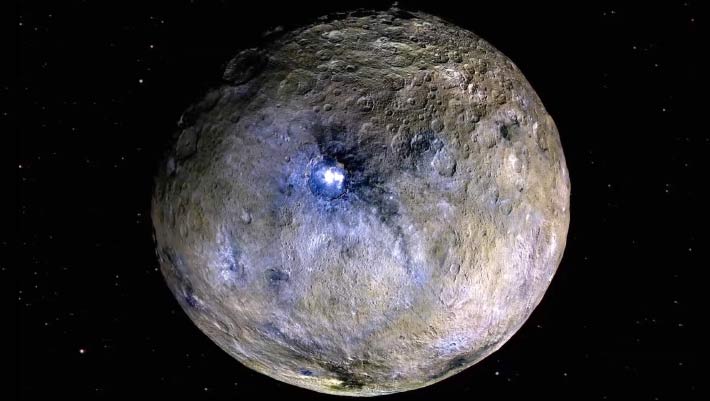How aliphatic organic compounds originated on the dwarf planet Ceres has been the subject of intensive research since their discovery by NASA’s Dawn mission in 2017. Some studies have concluded that a comet or other organic-rich impactor delivered them to Ceres; others indicate the molecules formed on the dwarf planet after its primordial materials were altered by briny water. New research led by Johns Hopkins Applied Physics Laboratory planetary scientists is extending our understanding of how impacts have affected Ceres’ aliphatic molecules and what the implications are for determining their origin and assessing the dwarf planet’s habitability.
This false-color image shows the dwarf planet Ceres. Scientists use false color to examine differences in surface materials. The color blue on Ceres is generally associated with bright material, found in more than 130 locations, and seems to be consistent with salts. Image credit: NASA / JPL-Caltech / UCLA / MPS / DLR / IDA.
“The organics were initially detected in the vicinity of a large impact crater, which is what motivated us to look at how impacts affect these organics,” said lead author Dr. Terik Daly, a planetary scientist at the Johns Hopkins Applied Physics Laboratory.
“Although researchers have performed impact and shock experiments on various types of organics in the past, what was missing was a study dedicated to the type of organics detected on Ceres using the same type of analytical method used by the Dawn spacecraft to detect them.”
Dr. Daly and colleagues conducted a series of experiments at the NASA Ames Vertical Gun Range.
The experiments mimicked the impact conditions typical of Ceres, with impact speeds ranging between 2-6 km/s (4,400-13,000 mph) and impact angles varying between 15 and 90 degrees relative to horizontal.
The authors also conducted a new analysis that combined data from two different instruments — the camera and the imaging spectrometer that flew on the Dawn spacecraft — and then used an algorithm to extrapolate the compositional information from the spectrometer down to the camera’s higher spatial resolution.
The results allowed them to investigate the organics at finer detail than has previously been possible.
“People had looked at the Dawn camera data and the Dawn spectrometer data separately, but no one else had taken the approach our team used to extrapolate the data from one instrument to another, which provided new leverage in our search to map and understand the origin of organics on Ceres,” said co-author Dr. Jessica Sunshine, an astronomer at the University of Maryland.
“By capitalizing on the strengths of two different datasets collected over Ceres, we’ve been able to map potential organic-rich areas on Ceres at higher resolution,” said Dr. Juan Rizos, an astrophysicist at the Instituto de Astrofisica de Andalucia.
“We can see a very good correlation of organics with units from older impacts and with other minerals like carbonates that also indicate the presence of water.”
“While the origin of the organics remains poorly understood, we now have good evidence that they formed in Ceres and likely in the presence of water.”
“There is a possibility that a large interior reservoir of organics may be found inside Ceres. So, from my perspective, that result increases the astrobiological potential of Ceres.”
The researchers hope the results from NASA’s Lucy mission will soon shed more light on organics in the Solar System.
“We will likely find differences, as the Trojan asteroids have experienced very different impact histories from Ceres, and because there are two compositionally different types of Trojan asteroids,” Dr. Sunshine said.
“Comparisons to Ceres will help up us understand the distribution of organics in the outer Solar System.”
The scientists present their findings today at the Geological Society of America’s GSA Connects 2023 meeting.
_____
R. Terik Daly et al. 2023. The effects of impacts on the reflectance spectra of aliphatic organics: implications for Ceres. Geological Society of America Abstracts with Programs 55 (6): 153-1; doi: 10.1130/abs/2023AM-392730




